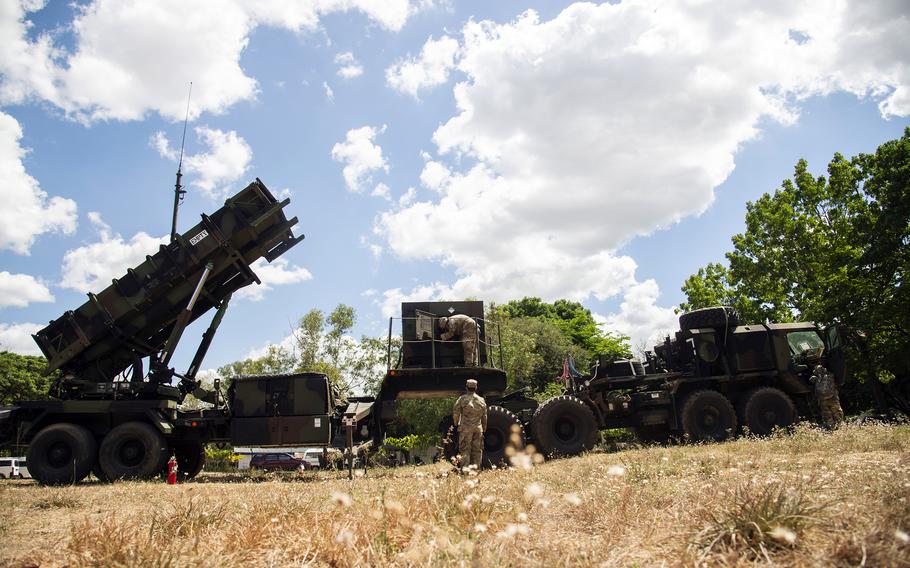
U.S. Army Spc. Rem Mendoza, top, Cpl. Christian Grantham, center, and Staff Sgt. Aaron Agsaoay, right, inspect a Patriot air-defense battery at Clark Air Base, Philippines, May 2, 2024. (Jonathan Snyder/Stars and Stripes)
CLARK AIR BASE, Philippines — The U.S. Army for the first time has deployed Patriot missile launchers to this sprawling facility shared by commercial and military aircraft north of Manila.
A pair of launchers from the Okinawa-based Bravo Battery, 1st Battalion, 1st Air Defense Artillery Regiment pointed skyward Thursday from a field at Clark’s Air Force City, home to Filipino airmen who share a nearby runway with commercial jets visiting Clark International Airport.
Around 50 soldiers from Bravo Battery are training to defend Clark from incoming missiles. It’s the same drill they’ve done across the Indo-Pacific in recent years as China rapidly grows its missile forces and vows to reunify the free and democratic island of Taiwan, by force if necessary.
In a conflict, experts expect U.S. installations in Japan, including on Okinawa, to come under heavy attack, which has led commanders to seek alternative air bases in the region to disperse their forces.
In 1991, Clark, then America’s largest overseas air base, suffered extensive damage from falling ash during the eruption of Mount Pinatubo. The installation was returned to the Philippines soon after but has continued to host visiting U.S. forces.
Last March, for example, F-22 Raptor stealth fighters from the Alaska-based 525th Fighter Squadron were photographed training at Clark.
The Patriot launchers, along with radar, an engagement control station and a command post, are deployed for the annual Balikatan exercise involving 16,000 mostly American and Filipino troops. Balikatan — Tagalog for “shoulder-to-shoulder” — began April 22 and wraps up May 10.
The American troops were sweating under a canopy next to a pile of water bottles Thursday while the sun beat down on their equipment and a nearby obstacle course.
In the past week they’ve conducted around 10 drills to rapidly position their gear or pack it up -- what they might do to make sure they’re not pinpointed by the enemy. It’s tough, physical work, made harder by the tropical heat.
The presence of civilians nearby – much of Clark has been converted from military facilities to business and leisure space in recent years - makes the training challenging, said battery commander Capt. April Dilidili as she stood near one of the launchers.
The air-defense soldiers are in the final portion of six months of training to certify the unit for real-world operations, she added.
The Patriot first came to Balikatan in 2022, when soldiers landed launchers in northern Luzon on Navy hovercraft. Last year, a Patriot fired for the first time in the islands, at Naval Station Leovigildo Gantioqui, also on Luzon.
Bravo Battery’s higher headquarters, the 38th Air Defense Artillery Brigade at Sagami General Depot near Tokyo, has been looking for new places to deploy the Patriots, said Maj. Trevor Wild, a brigade spokesman.
The air-defense battery is training alongside members of the Philippine air force’s 960th Air and Missile Defense Group, stationed at Cesar Basa Air Base, a short drive from Clark, he said during a break in training.
The Filipino airmen operate newly acquired Spyder air-defense systems, Wild said. They are made by the Israeli firm Rafael Advanced Defense Systems Ltd., the maker of the Iron Dome.
Spyder systems employ short-, medium- and long-range missiles to defend friendly forces, including maneuvering forces and wide areas, against threats from combat aircraft, helicopters, unmanned vehicles, bombers, cruise missiles and stand-off weapons, according to Rafael’s website.
Members of the U.S. brigade have been at Basa, one of several bases in the islands where American forces can operate under the 2014 Enhanced Defense Cooperation Agreement, teaching their counterparts to deconflict fires from the Patriot and Spyder systems, Wild said.
They’ve also been working with civil aviation authorities to avoid commercial aircraft operating near the air bases, said Maj. Jackson Cobb, an operations officer for the brigade.
He said about 25 soldiers from the brigade headquarters are providing command and control for Bravo Battery, as well as members of 1st Battalion, 188th Air Defense Artillery, a North Dakota National Guard unit, deployed to Naval Station Leovigildo Gantioqui.
The 25 Guard troops are equipped with Avenger short-range air-defense systems designed to shoot down manned and unmanned aircraft, Cobb said.
“Our objective is to conduct air- and missile-defense operations and also expeditionary deployment operations,” he said.
The training doesn’t involve firing live missiles, but the troops are training as if they are defending Clark, he said.